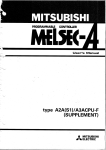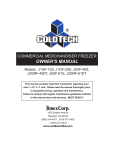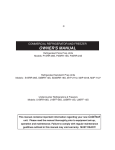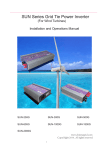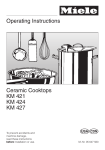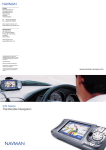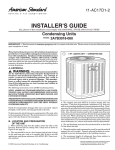Download Frigidaire FAD052M7A Air Conditioner
Transcript
Keep Well This Manual. Read Rules for Safe Operation and Instructions Carefully. WINDOW - TYPE AIR CONDITIONER CONTENTS 1. ELECTRICAL SAFETY RULES..............................................................1 2. UNIT PARTS IDENTIFICATION..............................................................2 3. POINTS FOR ATTENTION WHEN OPERATING....................................3 4. OPERATION PANEL(Cooling only type).....................................................4 OPERATION INSTRUCTION..................................................................4 5. CARE AND MAINTENANCE...................................................................7 6. WINDOW INSTALLATION INSTRUCTIONS.........................................10 7. TROUBLESHOOTING TIPS...................................................................15 ELECTRICAL SAFETY RULES CAUTION All wiring must comply with local and national electrical codes and be installed by a qualified electrician. If you have any questions regarding the following instructions, contact a qualified electrician. Never insert your fingers or any foreign objects into the air outlet. Take special care to warn children of these dangers. To avoid the possibility of personal injury, be sure to disconnect power to the unit before installing and/or servicing and/or cleaning. If the supply cord is damaged, it must be replaced by the manufacturer or its service agent or a similar qualified person in order to avoid a hazard. 1. The power cord is distinguished according to the cord color: 2. For your safety and protection, this unit is grounded through the power cord plug when plugged into a matching wall outlet. Please contact the manufacturer or its service agent or a similar qualified person if you want to replace it. 3. Electrical requirement. (See the specifications) 4. Be sure that the unit being correctly grounded. The wall outlet should be provided with reliable earth wire. 5. The unit should be provided with an individual branch circuit and the fuse size should be same as that of the power cord plug and wall outlet. 1 UNIT PARTS IDENTIFICATION 1 3 4 1. Front panel 2. Air filter 3. Frame 4. Cabinet 5. Air inlet grille (outdoor side) 6. Air outlet grille 7. Operation panel 8. Power supply and plug 2 5 6 7 8 Fig. 1 2 POINTS FOR ATTENTION WHEN OPERATING 1. During the course of operating, if you have turned off the unit or changed operation mode from COOLING MODE to FAN MODE, be sure to keep that state for at least three minutes before switching to COOLING MODE again. 2. Attaching the Air Filter Before starting the air conditioner operation, make sure that the air filter is well attached. If the unit has not been used for a long time, it is recommended to clean the air filter before your using the unit. For continuous use, clean the air filter at least once every two weeks. THREE MINUTES NO! 3. Before turning on the unit, make sure that the air inlet grille and air outlet grille are not obstructed by anything. 4. This air conditioner is designed to be operated under conditions as follows: Outdoor temp.: 18-43 C Indoor temp.: 21-32 C Cooling Operation Note: The relative humidity of room should be less than 80%. If the unit is used in a condition with a relative humidity over 80%, there will be condensed water on the surface of the unit. 5. If the unit is operated beyond the conditions specified above, it may cause a failure of the unit. 6. Relocation of the unit: When changing the installation location of the air conditioner, consult the selling agent from which you bought your unit. 3 OPERATION PANEL(Cooling only type) THERMOSTAT 6 5 SELECTOR OFF 7 HIGH COOL HIGH FAN 8 4 9 3 10 2 1 MED COOL LOW FAN LOW COOL 11 WAIT THREE MINUTES BEFORE RESTARTING Fig. 2 OPERATION INSTRUCTION OPERATION PANEL 1. Pull the top of the operation cover to open it. 2. Close the operation cover and press the top until it snaps into the locked position. Note: Don't press or swing the opened operation cover. Fig. 3 4 SELECTOR To set desired cooling temperature, simply rotate the SELECTOR knob to the appropriate setting. "HIGH FAN" will circulate the air at a maximum speed without cooling. SELECTOR "MED FAN" will circulate the air at a middle speed without cooling. OFF HIGH COOL HIGH FAN MED COOL LOW FAN "HIGH FAN" provides cooling automatically with maximum air circulation. "MED COOL" provides cooling automatically with middle air circulation. LOW COOL "LOW COOL" provides cooling automatically with minimum air circulation. "OFF" will completely shut off the unit. Note When turning the SELECTOR knob from "LOW COOL" to "HIGH COOL", keep your speed as slow as possible. Do not change the operation mode between "LOW COOL" and "HIGH COOL" too often. THERMOSTAT THERMOSTAT 5 6 7 8 4 9 3 10 2 1 11 The thermostat automatically starts and stops the running of the compressor in the air conditioner in order to control and maintain a comfortable room temperature. When the room temperature reaches the desired setting, cooling will automatically stop. When the room temperature rises above, cooling resumes. This results in efficient use of power and economical cooling. The operating method is as follows: turn along the arrow, the temperature setting becomes lower. When you feel it is too cool, rotate the knob to the original direction. When you feel it is too hot, rotate the knob to the "COOLER" direction. 5 Note During the cooling operation of the unit, when the thermostat knob is rotated counterclockwise, allow at least three minutes before turning back the knob to the "COOLER" direction. Otherwise the fuse may blow due to an overload of the unit. MANUAL LOUVER Horizontal air flow adjustment (manually) Move the "T" shaped handle left or right to adjust horizontal air flow. CLOSE VENT. Fig. 4 Vertical air flow adjustment (manually) To adjust vertical air flow direction, adjust any one of the horizontal louver blades. Fig. 5 6 FRESH AIR VENTILATION This is usually kept in the closed position and use only when clearing smoke and/or odors from the room. When the ventilation switch is pushed to "CLOSE", the fresh air ventilation is closed; when the ventilation switch is pushed to "VENT", the fresh air ventilation is opened. CLOSE . VENT. Note Keeping the fresh air ventilation opened for a long time will reduce the cooling effeciency. Fig. 6 CARE AND MAINTENANCE CAUTION To avoid the possibility of personal injury, be sure to disconnect power to the unit before servicing and/or cleaning. CHEMICALS Do Not use gasoline, benzene, thinner or any other chemicals, or any liquid insecticide on the air conditioner, as these substances may cause flaking off of the paint, cracking or deformation of plastic parts. Never attempt to clean the unit by pouring water directly over any of the surface areas, as this will cause deterioration of electrical components and wiring insulation. 7 CLEANING THE AIR FILTER If the air filter becomes clogged with dust, air flow is obstructed and reduces cooling efficiency. The air filter should be cleaned every two weeks. 6 3 9 WAI 1 T THR EE COOL ER MIN UTE HIGH COO L MED COO L OFF LOW COO L S BEF ORE LOW FAN HIGH FAN RES TAR TING Push Here Fig. 7 1. Removal of Air Filter 1) Press "PUSH" on the bottom corners of the inlet grill. See Fig. 7 2) Pull the air filter down to remove. 2. Cleaning of Air Filter 1) Remove the dust clogged in the filter by tapping it or vacuum clean it. 2) Wash the filter well with lukewarm water or a neutral cleaning agent. 3. Attaching the Air Filter Installation of the air filter is the reverse of the removal process. Note Never use hot water over 40 C(104 F) to clean th e air filter and air fresher. Never attempt to operate the unit without the air filter. 8 . . FRONT PANEL Dust may accumulate on the front panel, use soft wet cloth with a neutral cleaning agent to wipe it. Never use water over 50 C, alcohol, gasoline, acid, solvent or brush to clean the front panel as this will damage the surface of the part. End-of Season Care In-Season Care OPERATING THE FAN ALONE SEE PAGE 3 See POINTS FOR ATTENTION WHEN OPERATING on page 3. 1. Operating the fan alone for half a day to dry out the inside of the unit. 2. Turn off power and remove plug from wall outlet. 9 WINDOW INSTALLATION INSTRUCTIONS Parts Insluded 5. Window sash seat 6. Top mounting rail seal strip 7. Foam top window gasket 4. Top mounting rail 3. Accordion panel 13. Connection bar 1. Sill support 2. Bottom mounting rail 8. Type A (4) 9. Type B (9) 10. Type C (8) 11. Nut (2) 12. Bolt (2) Fig. 8 10 . . . . Window Requirements 5000 and 6000 BTU models These instructions are for a standard double-hung window. You will need to modify them for other types of windows. The air conditioner can be installed without the accordion panels if needed to fit in a narrow window. See the window opening dimensions below. All supporting parts must be secured to firm wood, masonry or metal. The electrical outlet must be within reach of the power cord. 14" min. 22" to 30" (With accordion panels) 17.5" min. (Without accordion panels) Fig. 9 Storm Window Requirements A storm window frame will not allow the air conditioner to tilt towards the outside and will keep it from draining properly. To adjust for this, attach a piece of wood to the stool. WOOD PIECES--WIDTH: 2" LENGTH: Long enough to fit inside the window frame. Wood 1 /2" higher than frame Stool Storm window frame THICKNESS: To determine the thickness, place a piece of wood on the stool to make it 1/ 2" higher than the top of the storm window frame. Attach securely with nails or screws provided by the installer. Remove the Air conditioner From the Case 1. Removal of Air Filter A. Press "PUSH" on the bottom corners of the inlet grill. Pull the air filter down to remove. 11 Fig. 10 B. Remove the 2 screws at the bottom, and remove the frame from the cabinet. Note: No need to remove the selector and thermostat knobs. C. Remove the 2 screws on each side of the case. Keep these for later use. D. Slide the air conditioner from the case by gripping the base pan handle and pulling forward while bracing the case. Fig. 11 Foam Fig. 12 Compressor Fig. 13 CAUTION! Be sure to remove the foam surrounding the compressor when installing. If not, it would harm the operation of the compressor. (See Fig.13) Fig. 14 Prepare the Window and the Case A. Cut the window sash seal to the proper length. Peel off the backing and attach the seal to the underside of the window sash. B. Remove the backing from the top mounting rail seal strip and attach it to the bottom of the top mounting rail. Fig. 16 Fig. 15 C. Install the top mounting rail with 4 type A screws on the outside of the case. Install the bottom rail inside of the case with 4 type C screws. Insert the frames for the accordion panels into the top mounting rail and the frame guides. 12 Top mounting rail Fig. 17 D. Install the Accordion panels 1 Attach the two Connection Bar to the case. 2 Connect the shutter with the Connection Bar. Shutter Connection Bar Fig. 18 3 Insert the shutters into its frame bar. And install the upper and lower frame bars. Fig. 19 4 Clip the shutters onto the frame bars with the clips. Upper Frame Bar Left Frame Bar Fig. 20 Fig. 21 Lower Frame Bar Install the Case in the Window A. Open the window and mark the centerline of the window stool. B. Carefully place the case on the window stool and align the center mark on the bottom front with the centerline of the stool. C. Pull the window down behind the top mounting rail. NOTE: Do not shut the window so tightly that the movement of the accordion panels is restricted. Fig. 22 13 D. Loosely assemble the sill supports. Indoor Outdoor Sill support Bolt E. Select the position that will place the sill supports near the outermost point on the sill. Attach the sill supports to the case track hole in relation to the selected position using 4 type C screws in each supports. Nut Fig. 23 Frame guide 1/3" Maximum Fig. 24 F. Adjust the bolt and the nut in each support so that the case is installed with a slight tilt to the outside. Use a level; about 1/3" will be the correct case slant to the outside. G. Secure the case to the window stool by using 6 type B screws. Sill support Fig. 25 H. Pull the accordion panels to each window sash track. Attach them on each side to the window sash and the window stool using 5 type B screws. Fig. 26 Install the Window Locking Bracket and the Foam Top Window Gasket A. Cut the foam top window gasket to the window width. B. Stuff the foam between the glass and the window to prevent air and insects from getting into the room. Fig. 27 14 Install the Air Conditioner in the Case The installation process is the reverse of the removal process on page 11 and 12. See Fig 11. Fig. 28 TROUBLESHOOTING TIPS Save time and money! Review the chart below first and you may not need to call for service. Problem Possible Causes Air conditioner does not start The air conditioner is unplugged. . . . What To Do Make sure the air conditioner plug is pushed completely into the outlet. The fuse is blown/circuit breaker is tripped. Check the house fuse/circuit breaker box and replace the fuse or reset the breaker. Power failure. If power failure occurs, turn the air conditioner OFF. When power is restored, wait 3 minutes to restart the air conditioner to prevent tripping of the compressor overload. 15 Problem Possible Causes Air conditioner does not cool as it should Airflow is restricted. . . . . . . .. . . . . . What To Do Make sure there are no curtains, blinds or furniture blocking the front of the air conditioner. The temp control may not be set correctly. On models with touch pads: In COOL mode, press the DECREASE pad. On modes with control knobs, turn the temperature knob to a higher number. The air filter is dirty. Clean the filter at least every 30 days. See the Operating Instructions section. When the air conditioner is first turned on you need to allow time for the room to cool down. Check for open furnace and cold air returns. Set the air conditioner's vent to the closed See "Air conditioner freezing up" below. The room may have been hot. Cold air is escaping. Cooling coils have iced up. Air conditioner freezing up Ice blocks the air flow and stops the air conditioner from cooling the room. On models with control knobs, set the mode control at HIGH FAN or HIGH COOL with the temp at 1 or 2. On models with touch pads, set the controls at HIGH (F3) FAN or HIGH (F3) COOL and set the thermostat to a higher temperature. Water drips outside Excessively hot and humid weather. This is normal. Water drips indoors The air conditioner is not tilted to the outside. Water collects in base pan Normal Operating Sounds For proper water disposal, make sure the air conditioner slants slightly from the case front to the rear. Moisture is removed from indoor air and drains into rear of a cabinet where a fan blows it against the outdoor condenser coil. This is normal for a short period in areas with little humidity; normal for a longer period in very humid areas. You may hear a pinging noise caused by water being picked up and thrown against the condenser on rainy days or when the humidity is high. This design feature helps remove moisture and improve efficiency. You may hear the thermostat click when the compressor cycles on and off. Water will collect in the base pan during high humidity or on rainy days. The water may overflow and drip from the outdoor side of the unit. The fan may run even when the compressor does not. 16 CS45-U 2200019260



















